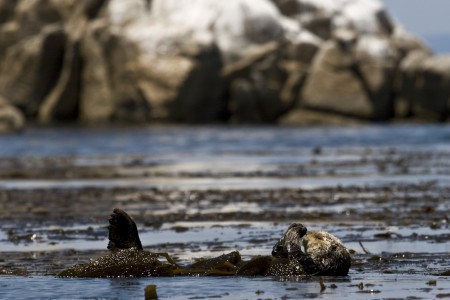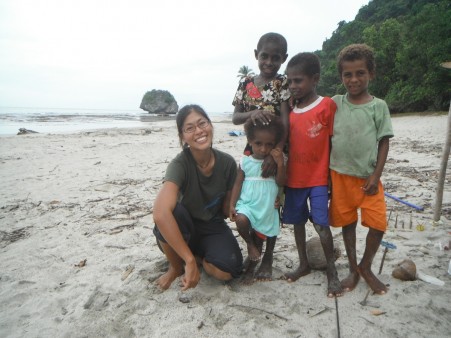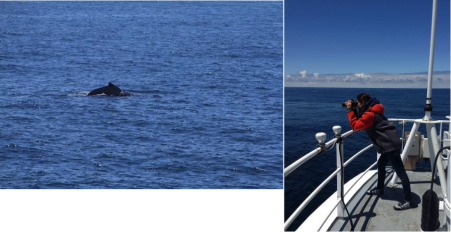by Angela Szesciorka, Vertebrate Ecology Lab
Since May, the mammal lab has been as quiet as a post-apocalyptic library (yep, that quiet). For the marine mammologist (and birder), summer time is all about fieldwork — followed by lots and lots of data crunching and thesis writing. So with fall drawing ever closer (noooooo!), I wanted to check in with my labmates to see what they have been up to. Below is a quick summary from each of us. We’ll see you soon!
Ryan Carle: Ryan continued working on Año Nuevo Island, finishing data collection for his thesis on Rhinoceros Auklet diet and reproduction. He spends most of his waking hours on the Island identifying prey, restoring habitat, counting burrows, collecting boluses — you name it. When he’s not on Año, he’s trekking about California and making apple cider!
Casey Clark: Casey has been fervently writing up his thesis as he prepares to defend in the fall. Draft one? Check! Falling asleep on your keyboard? Check! He has also been helping out with seabird research in Astoria, Oregon. He did save time for fun too — camping, hiking, and kayaking. Jealous!
Marilyn Cruickshank: Marilyn spent the summer analyzing BeachCOMBERS data. She’s looking to see if the residence times of stranded birds on Monterey beaches can help with damage assessments and as a predictor of where most birds will wash ashore in future oil spills. Marilyn continued working for the stranding network and learned how to program in Matlab. She even found time to carve a new banjo. Nice wood-working skills, Marilyn!
Emily Golson: Emily has been doing nothing but data analyses. Her sea otter movement model has been developed and now she is fitting parameters of the model using otter re-sighting data. Oil spill forecasting data (from the DFW and NOAA) will allow Emily to run a simulation of sea otter movements to estimate the number of sea otters that could be oiled (using various severities, different surface current circulation patterns, and times of year). Stay tuned, because this fall Emily will be presenting posters at the Oiled Wildlife Care Network’s Annual Rehabilitation Conference (Oilapalooza) and the Society for Marine Mammology’s 20th Biennial Conference on the Biology of Marine Mammals. We can’t wait!

Keith Hernandez: Keith started his sea lion diet study this summer. He’s been collecting scat off Año Nuevo Island with his collaborators and working with his summer intern, Ross Johnston, to process the scat; that is, removing and quantifying the hard parts and blending the remaining feces. Strong stomach, everyone, the poop room has returned!
Deasy Lontoh: As some of you may have read, Deasy traveled to Papua Barat, Indonesia (where she did her thesis data collection) to teach Indonesian school children about the threats that the endangered leatherback sea turtles face while nesting in Indonesia. Safe travels, Deasy!

Suzanne Manugian: Suzanne’s summer update: writing, writing, writing! She’s on chapter two of her thesis and expects her first draft to be done by September. She continues to monitor her seal haul-out sites, count seals for NPS, and will monitor marine mammals for the Bay Bridge project. A defense and marine mammal conference are looming in Suzanne's future. In her spare time, she’s been training for a few triathlons, a bike road race, and a half marathon... She also wrestles bears. Or so we hear. Kick-ass, Suzanne!
Melinda Nakagawa: Melinda is finishing up her thesis using remotely sensed oceanographic data to better characterize the California Current region (and the habitat of Sooty Shearwaters and their prey). Outside of that, her summer was spent chasing her little one around!
Gillian Rhett: Gillian is finishing up data collection and plans to graduate in the fall. She is using an epifluorescence microscope and scanning electron microscope to quantify and meiofauna (really small benthic invertebrates) from sediment cores that MBARI collected at whale fall sites in Monterey Bay. Gillian hopes to determine whether the meiofauna community is different under the whale bones versus the regular seafloor. Sooo cool, right?!?

Jacqueline Schwartzstein: This summer Jackie bade us farewell and moseyed up the Pacific Northwest to the evergreen state — Washington. Once there she kicked off her fieldwork, collecting gray whale prey data (benthic invert goodies, yum!) and got married. All in a days’ work. Congratulations, Jackie! Now get home because we miss you and your new hubby.
Angela Szesciorka: I started shipboard surveys in April. I’m basically a glorified ocean hitchhiker, riding vessels that are going between San Francisco and Los Angeles to survey for whales. Just me and the binos... well, and datasheets, food, and a helper, if I’m lucky. I’m hoping to do hotspot analysis with whale and ship distribution data to predict where ship-whale interactions might occur. Keith and I had an amazing journey on R/V Point Sur when we traveled from Oregon to Moss Landing in June. This August and September, I’ll be teaming up with John Calambokidis to tag humpback whales in the Traffic Separation Scheme off San Francisco. I hope to find out if humpback whale dive and foraging behavior is affected by the presence of large commercial vessels.

Lisa Webb: Lisa spent her summer working on her thesis on the foraging ecology of Brandt’s Cormorants in Monterey Bay. A thesis defense is in her future. Stay tuned!
*Update from Lisa: Between trips to the beach with her almost two year old daughter, Lisa has been preparing to present her thesis results on Brandt’s Cormorant diet in the Monterey Bay area at an upcoming workshop, Predators and The California Current Preyscape. The focus of the workshop is to gather information pertinent to management of forage fishes in the changing California Current System. Presentations will span a wide spectrum (invertebrates, fishes, seabirds, and marine mammals) and will highlight short and long-term changes observed at the scale that predators forage and compete. The adequacy of ecosystem based management will be discussed at the end of the workshop. The Brandt’s Cormorant is endemic to the California Current, forages nearshore, and the central California population is increasing, yet only a few diet studies have been conducted in Monterey Bay. Lisa’s study indicates a major shift from rockfishes and squid in the 1970s to a coastal pelagic, northern anchovy, and sanddabs in the 2000s. Additionally, due to greater sampling frequency than previous diet studies, Lisa has documented short-term prey switching in Brandt’s Cormorants, exemplifying their ability to capitalize on a sudden influx of prey.*
Kristine Williams: Kristine is finishing up her thesis looking at the effects of different health conditions on hematology and serum chemistries in California sea lions. She worked with The Marine Mammal Center, collecting her data from their Sausalito facility while becoming a registered veterinary technician. Way to go, Kristine! She is currently working on final revisions of her thesis. Expect to see her defend in the fall!

